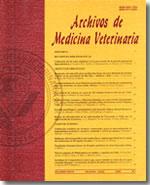Swine hepatitis E preliminary serological study in Chile
Main Article Content
Abstract
The hepatitis E virus (HEV) can cause acute epidemic hepatitis outbreak in humans. The path of transmission is oro-fecal, especially through contaminated water.It has been demonstrated that pigs can be infected with the human form of HEV. HEV antibodies and RNA from HEV have been found in pigs and other animals. Recently a new strain, called porcine HEV, was identified which differs from the human HEV. In Chile prevalence of anti-HEV in human general population reach 7%. However no studies have been made in pigs using ELISA and RT-PCR.
Two hundred and 175 serum samples from pigs of different ages and both sexes of Central Chile and Province of Valdivia, respectively were studied to determinate anti-HEV (IgG) by ELISA (Abbott Laboratories). RT-PCR was applied in 4 anti-HEV positive samples using human HEV sequence.
Nine point five percent (19/200) of the pigs in Central Chile and 0.6% (1/175) in the province of Valdivia were ELISA positive . The RT-PCR study of the four anti-HEV positive samples did not show the expected precipitation bands. Our preliminary results show the presence of HEV in pigs in Chile. However, further studies to evaluate the magnitude of the problem are necessary using swine HEV sequences. This will allow to determine the real significance of HEV in Chile.

